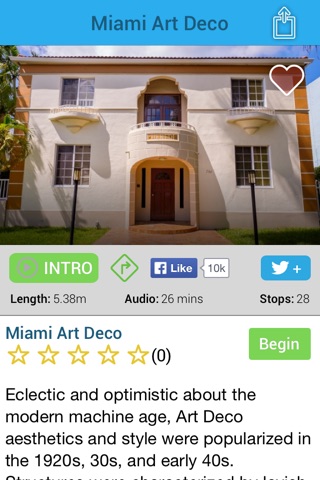
Miami Art Deco Tour app for iPhone and iPad
Developer: iTourMobile LLC
First release : 18 Sep 2015
App size: 38.64 Mb
Tour Miamis elaborate Art Deco scene in this GPS guided audio tour to 28 locations with 26 minutes of narrated audio as we take you to some of the most popular art deco spots in Miami.
Explore on location on a driving or walking tour, or from the comfort of your home! This limited version features 5 locations.
Get the full tour by downloading the itourmobile app at https://appsto.re/us/av5CG.i
Eclectic and optimistic about the modern machine age, Art Deco aesthetics and style were popularized in the 1920s, 30s, and early 40s. Structures were characterized by lavish ornamentation, sleek curves, fanciful ship-like touches, a bold use of colors and textures, and shiny terrazzo floors. The style represents exuberance, glamorous luxury, and faith in progress. All the buildings have their own personality and charm and nearly 100 years after they were built, these candy-like edifices provide a great home for some of the worlds most famous restaurants, bars and hotels.
The Art Deco style was used extensively in Miami Beach during the period between the World Wars. The Art Deco buildings were in very poor condition by the 1970s with many of them empty and derelict, and in grave risk of being torn down to redevelop the land. That is until concerned citizens worked hard to save the architecture of the area.
Today, the neighborhood of South Beach is on the National Register of Historic Places with more than 800 buildings noted as having historical significance. It is the first 20th century neighborhood so designated.
At the beginning of the Deco period, South Beach was what we would call today pristine natural barrier island coastline. Back then it was seen as undeveloped swampland and remote jungle-covered beach. Now it is thought of as the “Billion Dollar Sandbar,” and that may be undervaluing the area a bit.
Around the turn of the 20th century, John Collins – at age 70 -- bought the property to develop an avocado grove. Talk about a mid-life crisis, the island had everything he would need to succeed in the venture except for access to the mainland, cleared farmland, soil and fresh water. He found the fresh water two years later. Collins begin building a bridge and dredging a canal to provide the access to the island before running out of money. So he sold the land to John and James Lummus who saw the potential as a destination resort but did not have the cash to see the project through. One of their daughters is said to have coined the term South Beach before anything was even built.
Enter Carl Fisher, a wealthy winter resident of Miami and an early pioneer of the area. He had invented and sold an automotive product to Union Carbide. He had the vision and the capital to turn the beach into a city and thus be poised to profit from the land boom of the 1920s. His funding helped to finish the bridge Collins had started and in 1913 it became the longest wooden wagon bridge in the world. Fisher saw the potential of making the island a residential and hotel boomtown.
The area continued to grow until the mid 1960s when the Art Deco buildings became relegated to a largely fixed-income, senior citizen retirement community. By the early 80s the area of South Beach was very run down and considered by many as a “pastel-colored slum.”
Seeds of the South Beach renaissance were first apparent in 1976 with the formation of the Miami Design Preservation League, which had the vision to see that the Art Deco style of the period buildings could be priceless assets. It would be nearly a decade for the renovations of the properties took off.
*Note: Continued use of GPS in the background can dramatically decrease battery life. The app and GPS remain active in the background as you walk from place to place, so that you can listen to each location conveniently as you travel.



